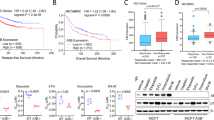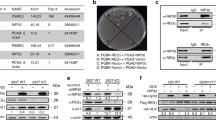Abstract
The protein kinase encoded by the ataxia telangiectasia and Rad3-related (ATR) gene is activated by DNA-damaging agents that are frequently used as anticancer therapeutics. Inhibition of ATR expression in cultured cancer cells has been demonstrated to increase sensitivity to chemotherapeutic drugs, including the DNA-crosslinking agent cisplatin. Cisplatin is a widely used and effective drug, but its use is associated with significant toxicity. Here, we demonstrate that genetic inhibition of ATR expression selectively enhanced cisplatin sensitivity in human colorectal cancer cells with inactivated p53. A knock-in strategy was used to restore wild-type p53 in cells harboring wild-type or mutant ATR alleles. Knock-in of functional p53 in ATR-deficient cells restored checkpoint function, suppressed apoptotic pathways and markedly increased clonogenic survival after cisplatin treatment. These results suggest that a strategy that combines specific inhibitors of ATR and conventional therapies might promote synthetic lethality in p53-deficient tumors, and thus minimize toxicity to normal tissues.
This is a preview of subscription content, access via your institution
Access options
Subscribe to this journal
Receive 50 print issues and online access
$259.00 per year
only $5.18 per issue
Buy this article
- Purchase on Springer Link
- Instant access to full article PDF
Prices may be subject to local taxes which are calculated during checkout





Similar content being viewed by others
Abbreviations
- ATM:
-
Ataxia telangiectasia mutated
- ATR:
-
ATM and Rad3-related
- HU:
-
hydroxyurea
- IR:
-
ionizing radiation
References
Alderton GK, Joenje H, Varon R, Borglum AD, Jeggo PA, O'Driscoll M . (2004). Seckel syndrome exhibits cellular features demonstrating defects in the ATR-signalling pathway. Hum Mol Genet 13: 3127–3138.
Blasina A, Hallin J, Chen E, Arango ME, Kraynov E, Register J et al. (2008). Breaching the DNA damage checkpoint via PF-00477736, a novel small-molecule inhibitor of checkpoint kinase 1. Mol Cancer Ther 7: 2394–2404.
Bunz F, Dutriaux A, Lengauer C, Waldman T, Zhou S, Brown JP et al. (1998). Requirement for p53 and p21 to sustain G2 arrest after DNA damage. Science 282: 1497–1501.
Bunz F, Hwang PM, Torrance C, Waldman T, Zhang Y, Dillehay L et al. (1999). Disruption of p53 in human cancer cells alters the responses to therapeutic agents. J Clin Invest 104: 263–269.
Cho SH, Toouli CD, Fujii GH, Crain C, Parry D . (2005). Chk1 is essential for tumor cell viability following activation of the replication checkpoint. Cell Cycle 4: 131–139.
Chung JH, Bunz F . (2010). Cdk2 is required for p53-independent G2/M checkpoint control. PLoS Genet 6: e1000863.
Cimprich KA, Cortez D . (2008). ATR: an essential regulator of genome integrity. Nat Rev Mol Cell Biol 9: 616–627.
Cliby WA, Roberts CJ, Cimprich KA, Stringer CM, Lamb JR, Schreiber SL et al. (1998). Overexpression of a kinase-inactive ATR protein causes sensitivity to DNA-damaging agents and defects in cell cycle checkpoints. EMBO J 17: 159–169.
Collis SJ, Swartz MJ, Nelson WG, DeWeese TL . (2003). Enhanced radiation and chemotherapy-mediated cell killing of human cancer cells by small inhibitory RNA silencing of DNA repair factors. Cancer Res 63: 1550–1554.
El-Deiry WS . (2003). The role of p53 in chemosensitivity and radiosensitivity. Oncogene 22: 7486–7495.
Hurley PJ, Bunz F . (2007). ATM and ATR: components of an integrated circuit. Cell Cycle 6: 414–417.
Hurley PJ, Wilsker D, Bunz F . (2007). Human cancer cells require ATR for cell cycle progression following exposure to ionizing radiation. Oncogene 26: 2535–2542.
Jallepalli PV, Lengauer C, Vogelstein B, Bunz F . (2003). The Chk2 tumor suppressor is not required for p53 responses in human cancer cells. J Biol Chem 278: 20475–20479.
Jazayeri A, Falck J, Lukas C, Bartek J, Smith GC, Lukas J et al. (2006). ATM- and cell cycle-dependent regulation of ATR in response to DNA double-strand breaks. Nat Cell Biol 8: 37–45.
Jiang H, Reinhardt HC, Bartkova J, Tommiska J, Blomqvist C, Nevanlinna H et al. (2009). The combined status of ATM and p53 link tumor development with therapeutic response. Genes Dev 23: 1895–1909.
Jirmanova L, Bulavin DV, Fornace Jr AJ . (2005). Inhibition of the ATR/Chk1 pathway induces a p38-dependent S-phase delay in mouse embryonic stem cells. Cell Cycle 4: 1428–1434.
Karnitz LM, Flatten KS, Wagner JM, Loegering D, Hackbarth JS, Arlander SJ et al. (2005). Gemcitabine-induced activation of checkpoint signaling pathways that affect tumor cell survival. Mol Pharmacol 68: 1636–1644.
Kastan MB, Bartek J . (2004). Cell-cycle checkpoints and cancer. Nature 432: 316–323.
Kodama M, Otsubo C, Hirota T, Yokota J, Enari M, Taya Y . (2010). Requirement of ATM for rapid p53 phosphorylation at Ser46 without Ser/Thr-Gln sequences. Mol Cell Biol 30: 1620–1633.
Li Q, Lin S, Wang X, Lian G, Lu Z, Guo H et al. (2009). Axin determines cell fate by controlling the p53 activation threshold after DNA damage. Nat Cell Biol 11: 1128–1134.
Matsuoka S, Ballif BA, Smogorzewska A, McDonald III ER, Hurov KE, Luo J et al. (2007). ATM and ATR substrate analysis reveals extensive protein networks responsive to DNA damage. Science 316: 1160–1166.
Meek DW . (2009). Tumour suppression by p53: a role for the DNA damage response? Nat Rev Cancer 9: 714–723.
Murga M, Bunting S, Montana MF, Soria R, Mulero F, Canamero M et al. (2009). A mouse model of ATR-seckel shows embryonic replicative stress and accelerated aging. Nat Genet 41: 891–898.
O'Driscoll M, Ruiz-Perez VL, Woods CG, Jeggo PA, Goodship JA . (2003). A splicing mutation affecting expression of ataxia-telangiectasia and Rad3-related protein (ATR) results in seckel syndrome. Nat Genet 33: 497–501.
Oda K, Arakawa H, Tanaka T, Matsuda K, Tanikawa C, Mori T et al. (2000). p53AIP1, a potential mediator of p53-dependent apoptosis, and its regulation by ser-46-phosphorylated p53. Cell 102: 849–862.
Osborn AJ, Elledge SJ, Zou L . (2002). Checking on the fork: the DNA-replication stress-response pathway. Trends Cell Biol 12: 509–516.
Pabla N, Huang S, Mi QS, Daniel R, Dong Z . (2008). ATR-Chk2 signaling in p53 activation and DNA damage response during cisplatin-induced apoptosis. J Biol Chem 283: 6572–6583.
Pirollo KF, Bouker KB, Chang EH . (2000). Does p53 status influence tumor response to anticancer therapies? Anticancer Drugs 11: 419–432.
Rago C, Vogelstein B, Bunz F . (2007). Genetic knockouts and knockins in human somatic cells. Nat Protoc 2: 2734–2746.
Reinhardt HC, Aslanian AS, Lees JA, Yaffe MB . (2007). p53-deficient cells rely on ATM- and ATR-mediated checkpoint signaling through the p38MAPK/MK2 pathway for survival after DNA damage. Cancer Cell 11: 175–189.
Reinhardt HC, Hasskamp P, Schmedding I, Morandell S, van Vugt MA, Wang X et al. (2010). DNA damage activates a spatially distinct late cytoplasmic cell-cycle checkpoint controlled by MK2-mediated RNA stabilization. Mol Cell 40: 34–49.
Reinhardt HC, Yaffe MB . (2009). Kinases that control the cell cycle in response to DNA damage: Chk1, Chk2, and MK2. Curr Opin Cell Biol 21: 245–255.
Robinson HM, Jones R, Walker M, Zachos G, Brown R, Cassidy J et al. (2006). Chk1-dependent slowing of S-phase progression protects DT40 B-lymphoma cells against killing by the nucleoside analogue 5-fluorouracil. Oncogene 25: 5359–5369.
Rui Y, Xu Z, Lin S, Li Q, Rui H, Luo W et al. (2004). Axin stimulates p53 functions by activation of HIPK2 kinase through multimeric complex formation. EMBO J 23: 4583–4594.
Ruzankina Y, Schoppy DW, Asare A, Clark CE, Vonderheide RH, Brown EJ . (2009). Tissue regenerative delays and synthetic lethality in adult mice after combined deletion of atr and Trp53. Nat Genet 41: 1144–1149.
Shiloh Y . (2006). The ATM-mediated DNA-damage response: taking shape. Trends Biochem Sci 31: 402–410.
Sur S, Pagliarini R, Bunz F, Rago C, Diaz Jr LA, Kinzler KW et al. (2009). A panel of isogenic human cancer cells suggests a therapeutic approach for cancers with inactivated p53. Proc Natl Acad Sci USA 106: 3964–3969.
Taira M, Nihira K, Yamaguchi T, Miki Y, Yoshida K . (2007). DYRK2 is targeted to the nucleus and controls p53 via phosphorylation in the apoptotic response to DNA damage. Mol Cell 25: 725–738.
Tibbetts RS, Brumbaugh KM, Williams JM, Sarkaria JN, Cliby WA, Shieh SY et al. (1999). A role for ATR in the DNA damage-induced phosphorylation of p53. Genes Dev 13: 152–157.
Topaloglu O, Hurley PJ, Yildirim O, Civin CI, Bunz F . (2005). Improved methods for the generation of human gene knockout and knockin cell lines. Nucleic Acids Res 33: e158.
Tse AN, Carvajal R, Schwartz GK . (2007). Targeting checkpoint kinase 1 in cancer therapeutics. Clin Cancer Res 13: 1955–1960.
Vousden KH, Lu X . (2002). Live or let die: the cell's response to p53. Nat Rev Cancer 2: 594–604.
Wagner JM, Karnitz LM . (2009). Cisplatin-induced DNA damage activates replication checkpoint signaling components that differentially affect tumor cell survival. Mol Pharmacol 76: 208–214.
Wagner JM, Kaufmann SH . (2010). Prospects for the use of ATR inhibitors to treat cancer. Pharmaceuticals 3: 1311–1334.
Waldman T, Kinzler KW, Vogelstein B . (1995). p21 is necessary for the p53-mediated G1 arrest in human cancer cells. Cancer Res 55: 5187–5590.
Wilsker D, Bunz F . (2007). Loss of ataxia telangiectasia mutated- and Rad3-related function potentiates the effects of chemotherapeutic drugs on cancer cell survival. Mol Cancer Ther 6: 1406–1413.
Wilsker D, Petermann E, Helleday T, Bunz F . (2008). Essential function of Chk1 can be uncoupled from DNA damage checkpoint and replication control. Proc Natl Acad Sci USA 105: 20752–20757.
Zenvirt S, Kravchenko-Balasha N, Levitzki A . (2010). Status of p53 in human cancer cells does not predict efficacy of CHK1 kinase inhibitors combined with chemotherapeutic agents. Oncogene 29: 6149–6159.
Zhang D, Zaugg K, Mak TW, Elledge SJ . (2006). A role for the deubiquitinating enzyme USP28 in control of the DNA-damage response. Cell 126: 529–542.
Acknowledgements
This work was supported by grants from the Flight Attendant Medical Research Institute and the NCI (T32CA121937).
Author information
Authors and Affiliations
Corresponding author
Ethics declarations
Competing interests
The authors declare no conflict of interest.
Rights and permissions
About this article
Cite this article
Sangster-Guity, N., Conrad, B., Papadopoulos, N. et al. ATR mediates cisplatin resistance in a p53 genotype-specific manner. Oncogene 30, 2526–2533 (2011). https://doi.org/10.1038/onc.2010.624
Received:
Revised:
Accepted:
Published:
Issue Date:
DOI: https://doi.org/10.1038/onc.2010.624
Keywords
This article is cited by
-
Phase 1b study of berzosertib and cisplatin in patients with advanced triple-negative breast cancer
npj Breast Cancer (2022)
-
Synthetic lethality in personalized cancer therapy
Genome Instability & Disease (2022)
-
Cytoglobin protects cancer cells from apoptosis by regulation of mitochondrial cardiolipin
Scientific Reports (2021)
-
ATR Inhibition Broadly Sensitizes Soft-Tissue Sarcoma Cells to Chemotherapy Independent of Alternative Lengthening Telomere (ALT) Status
Scientific Reports (2020)
-
ATR mediates cisplatin resistance in 3D-cultured breast cancer cells via translesion DNA synthesis modulation
Cell Death & Disease (2019)



